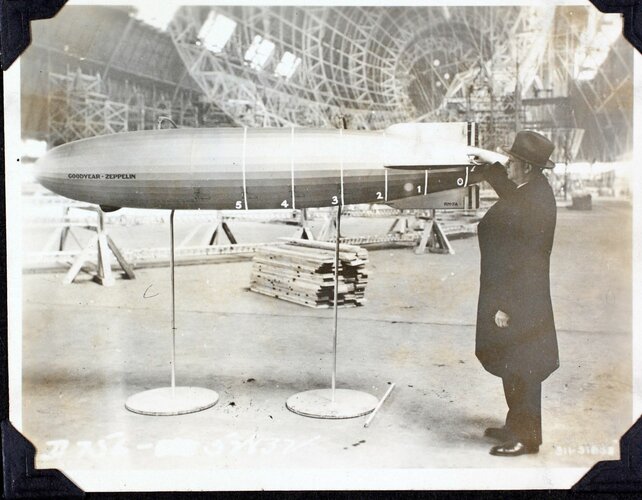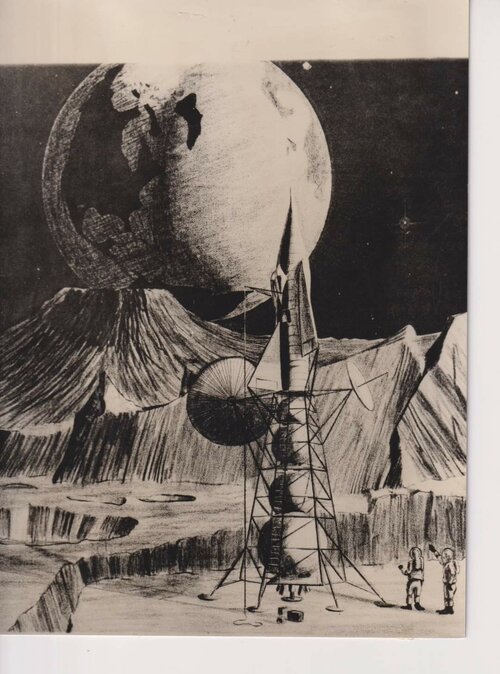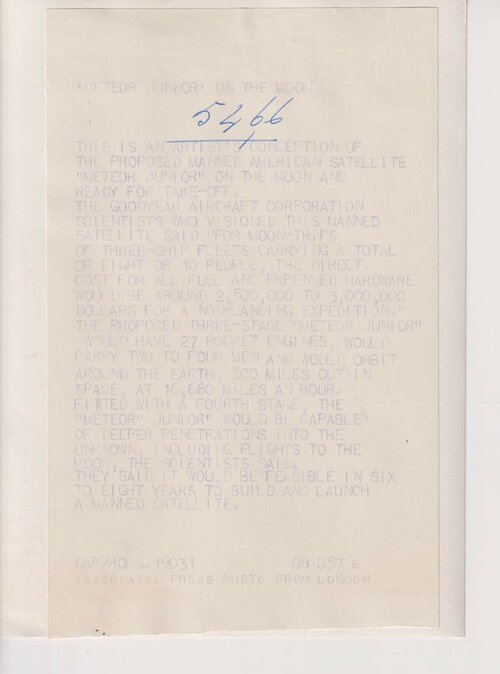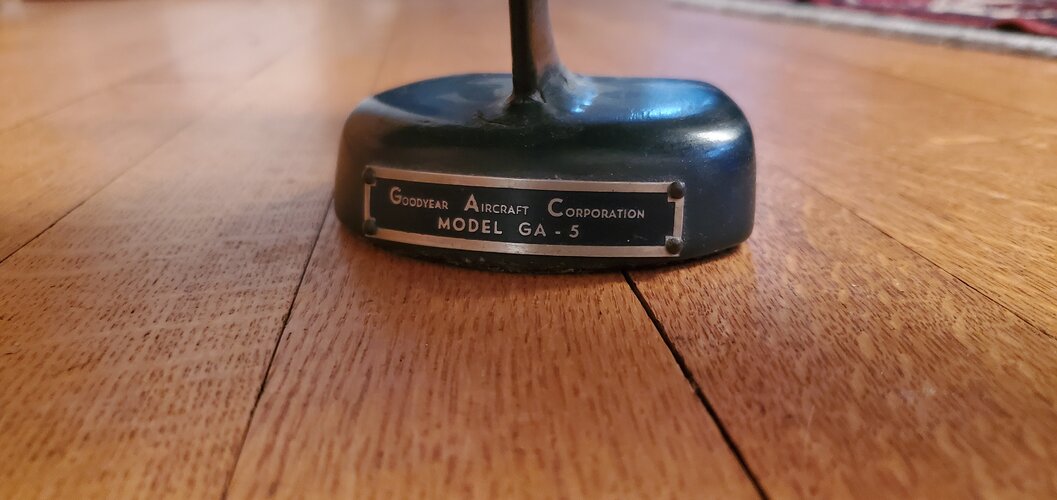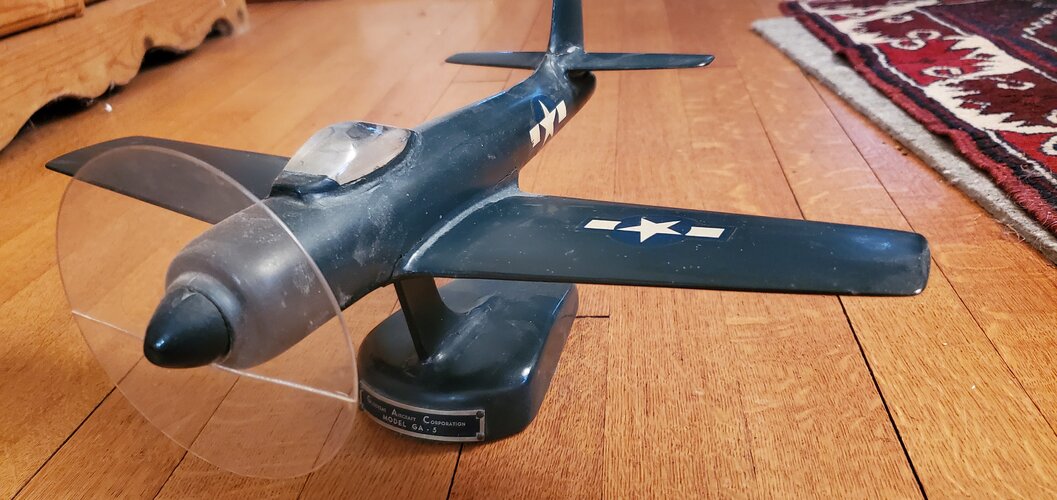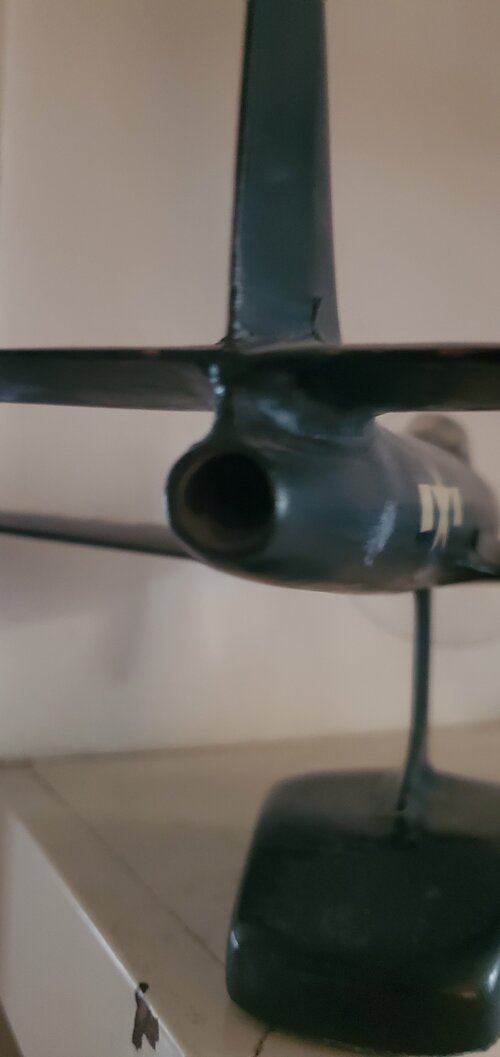You are using an out of date browser. It may not display this or other websites correctly.
You should upgrade or use an alternative browser.
You should upgrade or use an alternative browser.
Goodyear aircraft (GA-) and blimps (GZ-)
- Thread starter hesham
- Start date
Jos Heyman
ACCESS: Top Secret
- Joined
- 15 February 2007
- Messages
- 597
- Reaction score
- 80
To Stargazer
You have referred a number of times to Spangenberg. Can you elaborate? Is it a book or a website and if so, where can we find it.
(If you have done so already, apologies from my side).
You have referred a number of times to Spangenberg. Can you elaborate? Is it a book or a website and if so, where can we find it.
(If you have done so already, apologies from my side).
- Joined
- 25 June 2009
- Messages
- 14,754
- Reaction score
- 6,155
Sorry for not clarifying it in this particular topic. I did in a few others, but not systematically.
Our fellow forumite RyanCrierie was fortunate to have access to this huge amount of Navy-related archives and decided to photograph each of the pages from the general index to the 600+ boxes.
It is all explained here:
http://www.secretprojects.co.uk/forum/index.php/topic,9832.0/highlight,spangenberg.html
Our fellow forumite RyanCrierie was fortunate to have access to this huge amount of Navy-related archives and decided to photograph each of the pages from the general index to the 600+ boxes.
It is all explained here:
http://www.secretprojects.co.uk/forum/index.php/topic,9832.0/highlight,spangenberg.html
- Joined
- 25 June 2009
- Messages
- 14,754
- Reaction score
- 6,155
The history of Goodyear's involvement in airships and aviation is a long and fascinating one... but it's not always easy to understand the logic in the naming of the various types! I have worked on the subject on and off for many years now, and here's the result of my latest research:
1°) IN-HOUSE LETTER DESIGNATIONS
This is the system that was used by Goodyear in the first part of the company's history. Airships were given one- or two-letter type designations, but not following any apparent order or logic. For instance the Type F came first, then the U, then the A, then the C... Only the second letter, which determines the sub-type, is sequential as in FA, FB, FC, FD.
There has often been a confusion between these in-house designations and the ones used by the armed services to designate the same types, all the more so when the Army simply reused Goodyear's own (as they did initially).
2°) U.S ARMY DESIGNATIONS
It is hard to find the logic that prevailed in the naming of Army Air Service airships. Sometimes it was the Goodyear designation that is used, sometimes it was an alphabetical system of either one or two letters. It would seem also that there was no difference made (contrary to the Navy) between airships and balloons. Numerals were added to the type designator, for instance the Type TC airships (Goodyear's Type CA) were numbered TC-1, TC-2, TC-3 etc.
3°) GOODYEAR-ZEPPELIN DESIGNATIONS
At some point in the late 1920s, it seems Goodyear started to give unique GZ- designations to the airships it built. Unfortunately no trace seems to have remained of most of these. It is known however that the USS Akron (Navy's ZRS-4 rigid airship) was the GZ-1, while the TZ types Volunteer and Enterprise were G-3 and G-11, respectively.
4°) U.S. NAVY CLASS DESIGNATIONS
During the first World War, the Navy started a system whereby each new type of airship in service was given a Class letter. The A-Class was allocated to Connecticut Aircraft's DN-1 type (not a Goodyear product), the from the B-Class onwards it was Goodyear all the way, with Goodrich subcontracting a few. The Class system has its merits, if only because it is chronological and more or less contains all the main types developed by the company over the years.
All Navy airships carried a unique sequential numeral designation. For instance, C-Class airships (Goodyear's Type U) were C-1, C-2, C-3, etc. There was no exception to that system. However, they also carried the sequential serial number assigned to all the Navy's aircraft (C-1 to C-10 being also A-4118 to A-4127).
Free balloons, kite balloons and the likes (of which Goodyear built quite a few) did not follow such a well defined system, and very little information is available, anyway.
5°) U.S. NAVY MISSION/CLASS DESIGNATIONS
During the second World War, the system was made more complicated, with the old Class letter becoming the suffix of a much longer designator: former K-Class and M-Class blimps, for instance, became ZNP-K and ZNP-M, which indicated the type (Z = lighter-than-air), the construction (N = non-rigid) and the mission (N, then T = training, P = patrol). The numbering of types according to class (M-1, M-2...) was unchanged.
6°) U.S. NAVY INTERIM DESIGNATIONS
An interim system was used in the early 1950, which was almost the standard Navy system except that the Class letter replaced the constructor's letter as was the rule for aircraft designations. The prefix "W" was appended for early warning missions. For instance, ZP2N-1W indicated a patrol airship of the N-Class, first sub-type, AEW mission.
7°) U.S. NAVY STANDARDIZED DESIGNATIONS (1954)
The system was further standardized in 1954 to coincide with that of other Navy types: just like helicopters received HO (observation), HP (patrol), HR (assault) and HC (transport) prefixes, the airships received ZP (patrol) and ZS (sub-warfare) prefixes, followed by the G-for Goodyear letter. Indication of original Class letter was lost. The suffix "W" was appended to any subtype that would be used for early warning missions. For instance, ZP2N-1W became ZPG-2W.
8°) TRI-SERVICE STANDARDIZED DESIGNATIONS (1962 on)
Finally, the only three remaining types in U.S. Navy inventory were redesignated according to the new tri-service system adopted in 1962, still in use today. All were N-Class patrol types and were assigned the Z-1 designation. Prefix indicated the mission and suffix the version. In a streak of designation irony, a proposed 1977 naval airship by Goodyear was called the ZPG-X, indicating the lasting influence of the old system (ZPG-3W often continued to be called that way beyond 1962).
9°) U.S. NAVY RIGID AIRSHIPS
The prefix ZR was assigned to all rigid airships starting with the ZR-1 in 1923. The ZR-2 was the British Royal Airship Works R-38 specially built for the US Navy, but it crashed prior to delivery to the U.S., so that the next Goodyear rigid airship became the ZR-3 Los Angeles. Both have been added here for the sake of completion.
An additional letter was added for the mission on ZRS-4 and ZRS-5, indicating their use as scouting airships. ZRP (patrol), ZRN (training) and ZRCV (aircraft carrier) prefixes were also created, but when the promise of rigid airships went up in smoke, so to speak, with the loss of several famous ships, culminating in the Hindenburg disaster of 1933, none of these were used eventually, although the Navy continued to study the ZRCV concept until 1942 as a flying launch base for nine Douglas BT-1 attack planes.
10°) CIVIL REGISTRATIONS
The commercial airships produced by Goodyear (which were mostly of the TZ type) received sequential NC-*A designations (NC-7A to NC-16A are known). Since the 1960s, new registrations have been simplified as N*A (N1A, N2A, N3A...). In a few cases (airships lost or rebuilt) the same registrations were reused (NC-9A, N2A...).
11°) GOODYEAR AIRCRAFT CO./CORP. MODEL DESIGNATIONS (AIRSHIPS)
When the Goodyear Aircraft Co. was founded in 1939, a new system was used to designate current projects and existing types. All lighter-than-air types received a GZ- prefix. The reuse of the GZ- prefix has been a major source of confusion with the system described in 4°) above. Some mysteries remain here, such as the allocation of GZ-4, GZ-8 and GZ-18, as well as the apparent duplication of GZ-7 and GZ-11. I will be proposing explanations for these but they must be taken with a pinch of salt as there is currently no way to verify them. Finally, a non-standard three-digit designation, GZ-349, has been found for the V-Balloon, a 1966 Mobile LTA Vehicle (TVLF) proposal, with no further details.
12°) GOODYEAR AIRCRAFT CORP. MODEL DESIGNATIONS (AIRCRAFT)
Goodyear's aeronautical activities extended beyond lighter-than-air designs, and during the war they worked as a subcontractor to the Navy on Chance Vought's Corsair. During the 1950s, the prefix GA- was introduced for heavier-than-air designs. These covered a wide range of types, from seaplanes to inflatoplanes, from fighters to helicopters. Many of these designations are still undocumented, while several Goodyear-produced types still lack an identified designation (the Convoplane for instance). It is likely that many of the missing numbers relate to target drones such as the KD-6, missiles such as the Grebe or Subroc, and also space projects such as the Meteor Junior manned earth satellite.
13°) NAMES
Goodyear's commercial airships were nearly all christened with a name that was meant to be catchy and symbolic of American values. Mostly they were the names of the ships which early settlers traveled on: Puritan, Mayflower, Reliance... In some cases the names were reused for new airships, but usually with a number in roman letters (Mayflower III, Columbia II). In recent years, several Goodyear airships were rechristened in the "Spirit of..." series (Spirit of Innovation, Spirit of Goodyear...).
Goodyear's free balloons in the pre-war area, when christened, carried names such as Explorer, Explorer II or Goodyear II, III, IV...
Confused? You should be! (Who wouldn't?!)
1°) IN-HOUSE LETTER DESIGNATIONS
This is the system that was used by Goodyear in the first part of the company's history. Airships were given one- or two-letter type designations, but not following any apparent order or logic. For instance the Type F came first, then the U, then the A, then the C... Only the second letter, which determines the sub-type, is sequential as in FA, FB, FC, FD.
There has often been a confusion between these in-house designations and the ones used by the armed services to designate the same types, all the more so when the Army simply reused Goodyear's own (as they did initially).
- Type F = Navy B-Class (early)
- Type FA = Navy B-Class (late)
- Type FB = Navy E-Class
- Type FC = Navy F-Class; Army Class A
- Type FD = commercial, basis for Goodyear Type A
- Type FF = Army Class TA
- Type A = commercial "Pony Blimp" (pusher version)
- Type AA = commercial "Pony Blimp" (tractor version); Army Class OA
- Type AB = Navy H-Class; Army Class OB
- Type AC = Army Class AC
- Type AD = commercial "Pilgrim" or "Air Yacht"
- Type U = Navy C-Class
- Type UA = Navy D-Class
- Type CA = "Army Improved Class C" or Class TC
- Type J*? = Navy Class J (*designation as Goodyear Type J is especially dubious)
- Type TZ = main commercial series; many impressed by Navy in 1942 as L-Class, some returned to commercial use
- Type PA = commercial "Defender", impressed by Navy in 1942 as G-Class, lost in collision
2°) U.S ARMY DESIGNATIONS
It is hard to find the logic that prevailed in the naming of Army Air Service airships. Sometimes it was the Goodyear designation that is used, sometimes it was an alphabetical system of either one or two letters. It would seem also that there was no difference made (contrary to the Navy) between airships and balloons. Numerals were added to the type designator, for instance the Type TC airships (Goodyear's Type CA) were numbered TC-1, TC-2, TC-3 etc.
- Class A = Goodyear Type FC
- Class C = free balloons and kite balloons
- Class D = Goodyear airship (type unknown)
- Class J = Goodyear observation kite balloons
- Class M = Goodyear observation balloons
- Class O = Goodyear observation balloons
- Class R = Goodyear observation kite balloons
- Class AC = Goodyear Type AC
- Class OA = Goodyear Type AA
- Class OB = Goodyear Type AB (acquired on Navy contract)
- Class TA = Goodyear Type FF
- Class TC = Goodyear Type CA
- Class TE = Goodyear airship (type unknown)
- Class TF= Goodyear airship (type unknown)
- Class RN = Goodyear airship (type unknown)
- Class RS = Goodyear semi-rigid airship (Type RS?)
3°) GOODYEAR-ZEPPELIN DESIGNATIONS
At some point in the late 1920s, it seems Goodyear started to give unique GZ- designations to the airships it built. Unfortunately no trace seems to have remained of most of these. It is known however that the USS Akron (Navy's ZRS-4 rigid airship) was the GZ-1, while the TZ types Volunteer and Enterprise were G-3 and G-11, respectively.
4°) U.S. NAVY CLASS DESIGNATIONS
During the first World War, the Navy started a system whereby each new type of airship in service was given a Class letter. The A-Class was allocated to Connecticut Aircraft's DN-1 type (not a Goodyear product), the from the B-Class onwards it was Goodyear all the way, with Goodrich subcontracting a few. The Class system has its merits, if only because it is chronological and more or less contains all the main types developed by the company over the years.
All Navy airships carried a unique sequential numeral designation. For instance, C-Class airships (Goodyear's Type U) were C-1, C-2, C-3, etc. There was no exception to that system. However, they also carried the sequential serial number assigned to all the Navy's aircraft (C-1 to C-10 being also A-4118 to A-4127).
Free balloons, kite balloons and the likes (of which Goodyear built quite a few) did not follow such a well defined system, and very little information is available, anyway.
- A-Class = Connecticut Aircraft Type DN-1 (not Goodyear)
- B-Class = Goodyear Types F/FA
- C-Class = Goodyear Type U (some built by Goodrich)
- D-Class = Goodyear Type UA
- E-Class = Goodyear Type FB
- F-Class = Goodyear Type FC
- G-Class = Goodyear Type PA; later Goodyear GZ-7(?)
- H-Class = Goodyear Type AB
- I-Class (mention found but probably a mistake)
- J-Class = Goodyear Type J(?)
- K-Class = Goodyear Types GZ-6, GZ-10, GZ-12, GZ-15
- L-Class = Goodyear Type TZ (GZ-7)
- M-Class = Goodyear Type GZ-5
- N-Class = Goodyear Types GZ-9, GZ-11, GZ-14, (GZ-17)
- O-Class = Goodyear project, never completed
5°) U.S. NAVY MISSION/CLASS DESIGNATIONS
During the second World War, the system was made more complicated, with the old Class letter becoming the suffix of a much longer designator: former K-Class and M-Class blimps, for instance, became ZNP-K and ZNP-M, which indicated the type (Z = lighter-than-air), the construction (N = non-rigid) and the mission (N, then T = training, P = patrol). The numbering of types according to class (M-1, M-2...) was unchanged.
- ZNN-G > ZTN-G = G-Class training airship (redesignated as ZTG in 1947)
- ZNN-L > ZTN-L = L-Class training airship (redesignated as ZTL in 1947)
- ZNP-K = K-Class patrol airship (redesignated as ZPK)
- ZNP-M = M-Class patrol airship (redesignated as ZPM)
- ZNP-N = N-Class patrol airship (redesignated as ZPN)
6°) U.S. NAVY INTERIM DESIGNATIONS
An interim system was used in the early 1950, which was almost the standard Navy system except that the Class letter replaced the constructor's letter as was the rule for aircraft designations. The prefix "W" was appended for early warning missions. For instance, ZP2N-1W indicated a patrol airship of the N-Class, first sub-type, AEW mission.
- ZTG-1 = former ZTN-G
- ZTL-1 = former ZTN-L
- ZPK-1 = continuation of the K-Class series; former ZPN-K (redesignated as ZSG-1)
- ZP2K-1= Goodyear Type GZ-10; rebuild of K-class; larger envelope, volume increased (redesignated as ZSG-2)
- ZP3K-1= Goodyear Type GZ-10; rebuild of K-class; larger envelope, volume increased (redesignated as ZSG-3)
- X/ZP4K-1= Goodyear Type GZ-12 (redesignated as X/ZSG-4)
- X/ZPK5K-1 = Goodyear Type GZ-15 (redesignated as X/ZSG-5 and ZS2G-1)
- X/ZPN-1 = continuation of the N-Class series; former ZNP-N (redesignated as ZPG-1)
- X/ZPM-1 = former ZNP-M*
- ZP2N-1 = Goodyear Type GZ-11 improved N-class blimps
- ZP2N-1W = Goodyear Type GZ-14 AEW airship (redesignated as ZPG-2W)
7°) U.S. NAVY STANDARDIZED DESIGNATIONS (1954)
The system was further standardized in 1954 to coincide with that of other Navy types: just like helicopters received HO (observation), HP (patrol), HR (assault) and HC (transport) prefixes, the airships received ZP (patrol) and ZS (sub-warfare) prefixes, followed by the G-for Goodyear letter. Indication of original Class letter was lost. The suffix "W" was appended to any subtype that would be used for early warning missions. For instance, ZP2N-1W became ZPG-2W.
- ZPG-1 = Goodyear Type GZ-9 (former ZPN-1; redesignated as SZ-1A)
- ZPG-2 = Goodyear Type GZ-11 (former ZP2N-1)
- ZPG-2W = Goodyear Type GZ-14 (former ZP2N-1W; redesignated as EZ-1B)
- ZPG-3W = Goodyear Type GZ-17 (also known as the "Vigilance") (redesignated as EZ-1C)
- ZSG-1 = Goodyear Type GZ-6 (former ZPK-1)
- ZSG-2 = Goodyear Type GZ-10 (former ZP2K-1)
- ZSG-3 = Goodyear Type GZ-10 (former ZP3K-1)
- ZSG-4 = Goodyear Type GZ-12 (former ZP4K-1)
- ZSG-5 = Goodyear Type GZ-13 (former ZP5K-1)
- ZWG-1 = Goodyear Type GZ-16 (not built); initial proposal for an AEW airship; replaced by GZ-17
8°) TRI-SERVICE STANDARDIZED DESIGNATIONS (1962 on)
Finally, the only three remaining types in U.S. Navy inventory were redesignated according to the new tri-service system adopted in 1962, still in use today. All were N-Class patrol types and were assigned the Z-1 designation. Prefix indicated the mission and suffix the version. In a streak of designation irony, a proposed 1977 naval airship by Goodyear was called the ZPG-X, indicating the lasting influence of the old system (ZPG-3W often continued to be called that way beyond 1962).
- SZ-1A = former ZPG-1
- EZ-1B = former ZPG-2W
- EZ-1C = former ZPG-3W
9°) U.S. NAVY RIGID AIRSHIPS
The prefix ZR was assigned to all rigid airships starting with the ZR-1 in 1923. The ZR-2 was the British Royal Airship Works R-38 specially built for the US Navy, but it crashed prior to delivery to the U.S., so that the next Goodyear rigid airship became the ZR-3 Los Angeles. Both have been added here for the sake of completion.
An additional letter was added for the mission on ZRS-4 and ZRS-5, indicating their use as scouting airships. ZRP (patrol), ZRN (training) and ZRCV (aircraft carrier) prefixes were also created, but when the promise of rigid airships went up in smoke, so to speak, with the loss of several famous ships, culminating in the Hindenburg disaster of 1933, none of these were used eventually, although the Navy continued to study the ZRCV concept until 1942 as a flying launch base for nine Douglas BT-1 attack planes.
- ZR-1 = Naval Aircraft Factory USS Shenandoah rigid airship; first flight: 4 Sep 1923 (BuAer design)
- ZR-2 = Royal Airship Works R-38; unchristened, lost before delivery
- ZR-3 = Goodyear-Zeppelin LZ-126 USS Los Angeles rigid airship; first flight: 14 Oct 1924
- ZRS-4 = Goodyear USS Akron; started in 1925; delivered 25 Sep 1931; commissioned 27 Oct 1931; lost 3/4 April 1933
- ZRS-5 = Goodyear USS Macon; ordered in 1928; delivered and commissioned 23 June 1933; crashed 12 Feb 1935
- nd = Goodyear-Zeppelin LZ-131 "Super Hindenburg", started in 1933 but canceled after the Hindenburg crash
- ZRCV = rigid airship project designed as an aircraft carrier (for nine Douglas BT-1s); concept studied from 1935 to 1942
- ZRN = rigid training airship project (also conceived to carry nine Douglas BT-1s); also described as a cargo version
10°) CIVIL REGISTRATIONS
The commercial airships produced by Goodyear (which were mostly of the TZ type) received sequential NC-*A designations (NC-7A to NC-16A are known). Since the 1960s, new registrations have been simplified as N*A (N1A, N2A, N3A...). In a few cases (airships lost or rebuilt) the same registrations were reused (NC-9A, N2A...).
- NC-7A = Goodyear Type TZ Puritan; first flight 2 July 1928; crashed 21 Sep 1938
- NC-8A = Goodyear Type TZ Volunteer; first flight: April 1929
- NC-9A = Goodyear Type AD Pilgrim; first flight: 3 June 1925; first helium flight: 17 July 1925; in service from 1927 to 1931; reused for Goodyear Type TZ Rainbow in 1939
- NC-10A = Goodyear Type TZ Mayflower; reused by Ranger in 1940, lost and replaced (dubbed "Ghost Ship"); replacement ship impressed in 1942 as L-8
- NC-11A = Goodyear Type TZ Vigilant; rechristened Columbia from July 1931
- NC-12A = Goodyear Type PA Defender; in commercial service until 1934; in Navy service from September 1935 as G-1; lost in mid-air collision with L-2
- NC-13A = Goodyear Type TZ Neponset; became NC-18A Enna Jettick for Enna Jettick Shoes in 1931
- NC-14A = Goodyear Type TZ Reliance; first flight November 1931; impressed by US Navy in 1942 as L-6
- NC-15A = Goodyear Type TZ Resolute; first flight 1932; impressed by US Navy in 1942 as L-4
- NC-16A = Goodyear Type TZ Enterprise; impressed by US Navy in 1942 as L-5
- N1A = Mayflower IV, Stars & Stripes, Spirit of Innovation
- N2A = Columbia II, Europa, Eagle
- N3A = Columbia III, Stars & Stripes, Spirit of Goodyear
- N4A = Mayflower III, Silent Joe II (ARPA), Spirit of Akron
- N10A = America, Eagle
- N38A = Mayflower (strange registration needs confirmation)
11°) GOODYEAR AIRCRAFT CO./CORP. MODEL DESIGNATIONS (AIRSHIPS)
When the Goodyear Aircraft Co. was founded in 1939, a new system was used to designate current projects and existing types. All lighter-than-air types received a GZ- prefix. The reuse of the GZ- prefix has been a major source of confusion with the system described in 4°) above. Some mysteries remain here, such as the allocation of GZ-4, GZ-8 and GZ-18, as well as the apparent duplication of GZ-7 and GZ-11. I will be proposing explanations for these but they must be taken with a pinch of salt as there is currently no way to verify them. Finally, a non-standard three-digit designation, GZ-349, has been found for the V-Balloon, a 1966 Mobile LTA Vehicle (TVLF) proposal, with no further details.
- GZ-1 = described as a hospital dirigible project (possibly rigid)
- GZ-2 = ZRCV rigid airship aircraft carrier concept studied from 1935 to 1942; provision for nine BT-1 attack aircraft
- GZ-3 = ZRN rigid airship for training; provision for nine BT-1 attack aircraft
- GZ-4 = allocation unknown (could explain the GZ-7 confusion?)
- GZ-5 = ZNP-M > ZPM/ZP2M
- GZ-6 = ZNP-K > ZPK
- GZ-7 = ZNN-G > ZTN-G > ZTG; new design; designation also said to apply to all Type TZ airships (was either of these the GZ-4?)
- GZ-8 = possibly the uncompleted O-Class airship
- GZ-9 = ZNP-N > ZPN-1 > SZ-1A; design in competition with Douglas 581; first flight: 18 June 1951
- GZ-10 = ZP2K-1/ZP3K-1 > ZSG-2/ZSG-3; rebuilds of K-class; larger envelope, volume increased
- GZ-11 = ZP2N-1 > ZPG-2; improved N-class; designation also said to apply to a projected nuclear-powered AEW airship (mistake?)
- GZ-12 = ZP4K-1 > ZSG-4
- GZ-13 = XZP5K-1 >XZSG-5; new design; produced as GZ-15 (GZ-13/A also found as "AEW airship with stern propulsion")
- GZ-14 = ZP2N-1W > ZPG-2W > EZ-1B AEW airship (designation ZWN also found but unconclusive)
- GZ-15 = ZP5K-1 > ZSG-5 and ZS2G-1; production model of GZ-10
- GZ-16 = proposed XZWG-1 AEW airship (mockup only); replaced by ZPG-3W
- GZ-17 = ZPG-3W > EZ-1C; largest non-rigid airship ever built
- GZ-18 = allocation unknown
- GZ-19 = commercial advertising type; Mayflower also used by ARPA as Silent Joe II to evaluate surveillance over the Ho Chi Minh trail
- GZ-19A = enlarged GZ-19; Volunteer II (former Navy L-17), Mayflower II (former Navy L-14), Ranger II (former Navy L-18)
- GZ-20 = commercial advertising type; America (former Navy L-8 and Ranger), Columbia III (former Navy L-16 and Enterprise II)
- GZ-20A = main modern commercial advertising type; Europa, Mayflower, Eagle, Spirit of Innovation, Stars & Stripes, Spirit of America, Spirit of Goodyear
- GZ-21 = one-off commercial advertising type
- GZ-22 = Spirit of Akron; also known as the Loral GZ-22
12°) GOODYEAR AIRCRAFT CORP. MODEL DESIGNATIONS (AIRCRAFT)
Goodyear's aeronautical activities extended beyond lighter-than-air designs, and during the war they worked as a subcontractor to the Navy on Chance Vought's Corsair. During the 1950s, the prefix GA- was introduced for heavier-than-air designs. These covered a wide range of types, from seaplanes to inflatoplanes, from fighters to helicopters. Many of these designations are still undocumented, while several Goodyear-produced types still lack an identified designation (the Convoplane for instance). It is likely that many of the missing numbers relate to target drones such as the KD-6, missiles such as the Grebe or Subroc, and also space projects such as the Meteor Junior manned earth satellite.
- U.S. Navy FG-1 / FG-1A / FG-1D Corsair
- U.S. Navy FG-2 Corsair
- U.S. Navy FG-3 Corsair
- U.S. Navy FG-4 Corsair
- Royal Air Force Corsair IV
- U.S. Navy XF2G-1 / F2G-1 / F2G-1D Corsair
- U.S. Navy F2G-2 Corsair
- GA-1 Duck prototype two-seater of 1944; 107 hp (80 kW) Franklin 4ACG-100-H3 piston engine, later a 125 hp (93 kW) Franklin 6A engine
- GA-2 Duck three-seat pusher amphibian with a 145 hp (108 kW) Franklin 6A4-145-A3 engine (16 examples produced)
- GA-2B Duck three-seat aircraft with a 165 hp (123 kW) Franklin 6A4-163-B3 engine (6 modified)
- GA-3 three-place pusher amphibian project
- GA-5 (designation found; no information)
- GA-13 (designation found; no information)
- GA-16 (designation found; no information)
- GA-17 (designation found; no information)
- GA-22 Drake revised larger variant of Duck with four-seats, one built (1950)
- GA-22A Drake powered by a 225 hp (167 kW) Continental E-225-8 and converted into a flying boat with a revised hull, one built (1953)
- GA-27A US Navy proposal, no details
- GA-27B US Navy proposal, no details
- GA-28A VTO Convoy Fighter proposal for US Navy, not built
- GA-28B VTO Convoy Fighter proposal for US Navy, alternate configuration
- GA-33 Inflatoplane prototype
- GA-34 US Navy proposal, no details
- GA-39 COIN (Counter-Insurgency Aircraft) proposal, competitor of OV-10
- GA-400R / GA-400R-3J / GA-400T Gizmo ultra-light helicopter
- GA-447 Inflatoplane
- GA-466 Inflatoplane (Army YAO-2G)
- GA-468 Inflatoplane (Army XAO-3G)
13°) NAMES
Goodyear's commercial airships were nearly all christened with a name that was meant to be catchy and symbolic of American values. Mostly they were the names of the ships which early settlers traveled on: Puritan, Mayflower, Reliance... In some cases the names were reused for new airships, but usually with a number in roman letters (Mayflower III, Columbia II). In recent years, several Goodyear airships were rechristened in the "Spirit of..." series (Spirit of Innovation, Spirit of Goodyear...).
Goodyear's free balloons in the pre-war area, when christened, carried names such as Explorer, Explorer II or Goodyear II, III, IV...
Confused? You should be! (Who wouldn't?!)
Jos Heyman
ACCESS: Top Secret
- Joined
- 15 February 2007
- Messages
- 597
- Reaction score
- 80
Wow!
unclejim
ACCESS: Confidential
- Joined
- 6 December 2010
- Messages
- 77
- Reaction score
- 5
Excellent work.
I do not think Goodyear had anything to do with ZR-2(LZ-126) except as possilby observers on Zepplin construction techniques. ZR-2 was built as war reparations for the US, and delivered to America to be cristened as USS Los Angeles. I have also never seen any evidence that Goodyear was ever involved in LZ-131.
I do not think Goodyear had anything to do with ZR-2(LZ-126) except as possilby observers on Zepplin construction techniques. ZR-2 was built as war reparations for the US, and delivered to America to be cristened as USS Los Angeles. I have also never seen any evidence that Goodyear was ever involved in LZ-131.
- Joined
- 25 June 2009
- Messages
- 14,754
- Reaction score
- 6,155
unclejim said:Excellent work.
I do not think Goodyear had anything to do with ZR-2(LZ-126) except as possilby observers on Zepplin construction techniques. ZR-2 was built as war reparations for the US, and delivered to America to be cristened as USS Los Angeles. I have also never seen any evidence that Goodyear was ever involved in LZ-131.
I think you meant ZR-3, not ZR-2... Anyway, I'll have to investigate that question further. Thanks a lot for reading this through, which isn't an easy thing to do!!
- Joined
- 5 May 2007
- Messages
- 351
- Reaction score
- 409
I'm not quite sure if this is the right topic, but here are some photos of USS Akron (ZRS-4) recently posted by the US National Archives at their Commons photostream on Flickr:
http://www.flickr.com/photos/usnationalarchives/sets/72157631511771730/with/7951496116/
A couple of samples:


http://www.flickr.com/photos/usnationalarchives/sets/72157631511771730/with/7951496116/
A couple of samples:
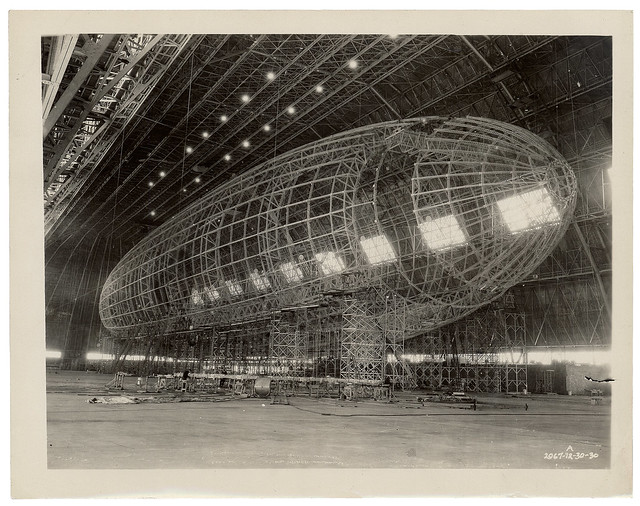
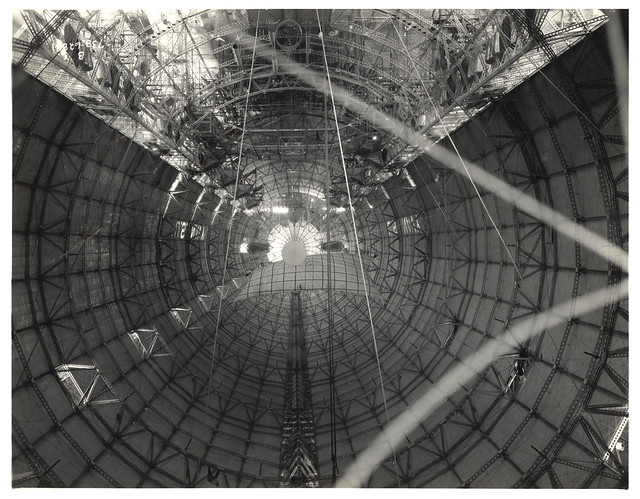
GA-5 was an early 1945 proposal for a carrier-based fighter powered by both a P&W R-2800 piston engine and a Westinghouse 24C jet engine similar to the Ryan FR and the Curtiss F15C.
GA-13 was a carrier-based night fighter proposed against the requirement that resulted in the F3D Skynight.
GA-13 was a carrier-based night fighter proposed against the requirement that resulted in the F3D Skynight.
GA-16 was a swept-wing "penetration fighter" powered by two Westinghouse 24C jet engines and proposed to the Air Force in October 1945.
Steve Pace
Aviation History Writer
- Joined
- 6 January 2013
- Messages
- 2,266
- Reaction score
- 225
I'm not positive but I feel GAC must have assigned a GA number to its production of the Corsair (GA-5?). -SP
- Joined
- 25 June 2009
- Messages
- 14,754
- Reaction score
- 6,155
Steve Pace said:I'm not positive but I feel GAC must have assigned a GA number to its production of the Corsair (GA-5?). -SP
They didn't. The first GA- number (GA-1) was allocated in 1944 to the first two-seater Duck prototype. The GA-2 was the three-seat production version.
All the Goodyear variants of the Vought Corsair (FG-1, FG-1A, FG-1D, FG-2, FG-3, FG-4) and of their own Super Corsair (XF2G-1, F2G-1, F2G-1D, F2G-2) were developed prior to that aircraft.
For your information, GA-3 was a projected three-place pusher amphibian. I do not know what GA-4 might have been. GA-5 was an early proposal for a carrier-based fighter powered by both a P&W R-2800 piston engine and a Westinghouse 24C jet engine, similar to Ryan FR and Curtiss F15C.
Steve Pace
Aviation History Writer
- Joined
- 6 January 2013
- Messages
- 2,266
- Reaction score
- 225
Thanks for the info! -SP
Apologies ahead of time if this is off-topic...
Regarding the F2G series, was the developmental engineering for the "Super Corsair" performed in-house by Goodyear, or was their substantial outside assistance from Vought?
My recollection is that Pratt & Whitney originated the idea for mating an R-4360 engine to a Corsair in late '43, resulting in the F4U-1WM prototypes. The aircraft had been rebuilt by Vought. Shortly thereafter, the Wasp Major Corsair project had been transferred to Goodyear to allow Vought to focus on the F4U-4. From that point, Goodyear's engineering staff should have been able to develop the F4U-1WM into the F2G series. Not sure if Goodyear's work on fitting bubble canopies to Corsairs had started as a parallel effort to the Wasp Major engine, or if the effort began after Goodyear had started gearing up for the Super Corsair program.
Regarding the F2G series, was the developmental engineering for the "Super Corsair" performed in-house by Goodyear, or was their substantial outside assistance from Vought?
My recollection is that Pratt & Whitney originated the idea for mating an R-4360 engine to a Corsair in late '43, resulting in the F4U-1WM prototypes. The aircraft had been rebuilt by Vought. Shortly thereafter, the Wasp Major Corsair project had been transferred to Goodyear to allow Vought to focus on the F4U-4. From that point, Goodyear's engineering staff should have been able to develop the F4U-1WM into the F2G series. Not sure if Goodyear's work on fitting bubble canopies to Corsairs had started as a parallel effort to the Wasp Major engine, or if the effort began after Goodyear had started gearing up for the Super Corsair program.
- Joined
- 5 May 2007
- Messages
- 351
- Reaction score
- 409
Came across more photos of the Akron over at the San Diego Air & Space Museum (SDASM) Archives on Flickr - (Glenn W. Bates album). With respect to this topic, this photo intrigued me. The photo was taken inside the Goodyear Airdock during the construction of either the USS Akron or USS Macon, and it features a representative model / construction model of the airships. (EDIT: The photo also appears to include designer Karl Arnstein). On the side of the model it says "Goodyear-Zeppelin," as one might expect. However, the lower tail-fin carries the designation "RM-7A". Any ideas if this is a design number? Google has failed me after searching variously and in combination for "USS Akron", "USS Macon," "Goodyear-Zeppelin," etc., and, of course "RM-7A." :-\
Here's the photo in question:
View: http://www.flickr.com/photos/sdasmarchives/10561645964/

And here's the link to the largest resolution version of the of the photo, where one can clearly see "RM-7A" on the lower tail-fin.
View: http://www.flickr.com/photos/sdasmarchives/10561645964/sizes/o/
Here's the photo in question:
View: http://www.flickr.com/photos/sdasmarchives/10561645964/
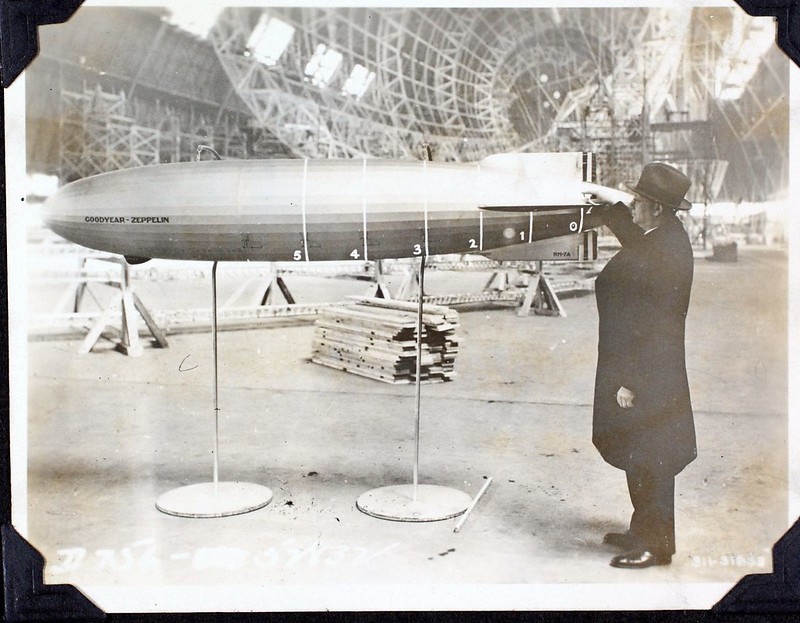
And here's the link to the largest resolution version of the of the photo, where one can clearly see "RM-7A" on the lower tail-fin.
View: http://www.flickr.com/photos/sdasmarchives/10561645964/sizes/o/
Attachments
Last edited:
- Joined
- 25 June 2009
- Messages
- 14,754
- Reaction score
- 6,155
hesham said:Hi,
in 1949,Goodyear designed a fighter-bomber shipboard jet aircraft Project,had a mid-swept wing and V-tail,powered
by two GE TG190B (J47) engines,fed through unusual 'split-chin' air intakes.
Source?
- Joined
- 9 October 2009
- Messages
- 21,979
- Reaction score
- 13,645
- Joined
- 26 May 2006
- Messages
- 34,917
- Reaction score
- 15,791
Hi,
in 1949,Goodyear designed a fighter-bomber shipboard jet aircraft Project,had a mid-swept wing and V-tail,powered
by two GE TG190B (J47) engines,fed through unusual 'split-chin' air intakes.
May this concept was taken the designation GA-21 ?.
My late father-in-law was an engineer for GAC during WWII and played a major role on the development of the F2G. Among the things we found after he had passed was a wooden model of a proposed GAC aircraft that is labeled as a "GA-5" and one that certainly looks as if it was intended to be a rival bid for the Ryan Fireball (i.e, propeller upfront, jet exhaust in the rear of the fuselage). Can anyone shed any light on this?
Last edited:
- Joined
- 25 July 2007
- Messages
- 4,299
- Reaction score
- 4,198
My late father-in-law was an engineer for GAC during WWII and played a major role on the development of the F2G. Among the things we found after he has passed was a wooden model of a proposed GAC aircraft that is labeled as a "GA-5" and one that certainly looks as if it was intended to be a rival bid for the Ryan Fireball (i.e, propeller upfront, jet exhaust in the rear of the fuselage). Can anyone shed any light on this?
Do you still have this model? Or, by chance, took a photo of it when found?
We seem to have found little about the GA-5. Tommy Thomason speculated that the GA-5 may have been a rather late, unsolicited proposal (the concept being submitted after the Ryan FR had already flown.
Have a glance at the patent drawings in the post linked below. Does the depicted concept resemble your father-in-law's model?
-- https://www.secretprojects.co.uk/threads/competition-of-ryan-fr-1-fireball.5151/#post-331654
- Joined
- 25 June 2009
- Messages
- 14,754
- Reaction score
- 6,155
- Joined
- 26 May 2006
- Messages
- 34,917
- Reaction score
- 15,791
GA-39 COIN (Counter-Insurgency Aircraft) proposal, competitor of OV-10
It was also called GA-340.
Similar threads
-
New book on the Goodyear GA-28A/B Convoy Fighter!
- Started by jzichek
- Replies: 15
-
Atlantic Fokker/General Aviation model designations
- Started by Stargazer
- Replies: 0
-
-
-
Prefix letters for US and Canadian manufacturers' designations
- Started by Stargazer
- Replies: 5

